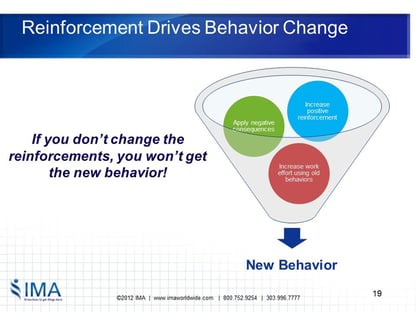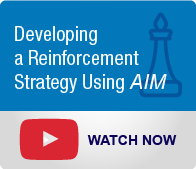There is a fundamental principle of human behavior that states, “People follow the reinforcement.” In other words, if you want people to change what they are doing, you have to alter the reinforcements. That's why Don Harrison, President and founder of IMA, tells our clients that "every time you see a behavior, there either is or was a reward for it." No behavior occurs in isolation of reinforcement. 
So if (hypothetically speaking, of course) you see a lot of political turf-guarding in your organization, it’s because there has been or is now some reward for that.
With this in mind, it is easy to understand why one of the key elements of the Accelerating Implementation Methodology (AIM) is to “Develop a Reinforcement Strategy” for your project. The more significant your change, such as transformation, the more important it becomes to develop implementation-specific rewards and consequences. But remember, reinforcement management is less about the formal compensation and performance management systems and much more about the daily interaction between a Sponsor and his or her direct reports.
By following the below 5 key AIM principles of reinforcement, and by applying them tactically throughout a change on an ongoing basis, Change Agents will be much more likely to motivate individuals to change their behavior, which ultimately leads to adoption and benefit realization for the investment being made.
5 Key Principles for Reinforcement
- Performance Management - Superior performance is gained through managing all aspects of the relationship between manager and direct report. This is more than the formal performance appraisal process, and goes beyond the assumption that each employee should motivate him or herself.
- Reinforcement Needs to be from the Frame of Reference of the Individual - This means for any reinforcement to impact behavior, it must have meaning or value for the individual you are trying to motivate. You probably won't find a single reinforcement that motivates everyone.
- Immediacy of Reinforcement - Reinforcements have to be applied as soon as possible following the behavior, and must be directly connected to that behavior. For example, you can’t wait for the annual performance review as the method for reinforcement; the timing is just too infrequent.
- Positive vs. Negative Reinforcement - For maximum acceleration, risk-taking, and innovation, employees must perceive there will be a higher likelihood of positive consequences for at least attempting to achieve results, versus negative consequences for making mistakes. However, you do need a mix of both!
- Informal Reinforcement - Change Agents should focus on working on the application by Sponsors of daily informal reinforcements to motivate for superior performance.
Reinforcement Management
Reinforcement management includes rewards, consequences, and level of work effort. These three different levers can be applied to drive behavior change. To go from an old behavior to a new behavior:
- Decrease the rewards for the old: increase the rewards for the new
- Increase the negative consequences for the old ways; decrease any negative consequences for the new
- Increase the level of effort for the old; decrease the level of effort for the new (make it easier to use)
However, keep in mind that you will need to build in many more positive rewards than negative consequences to drive the migration of new behaviors because people tend to focus on the negative much more than on the  positive. Most people have experienced a situation where there was lots of positive feedback for some work effort, and just a single negative comment. But what sticks in our heads? Of course, that one negative comment!
positive. Most people have experienced a situation where there was lots of positive feedback for some work effort, and just a single negative comment. But what sticks in our heads? Of course, that one negative comment!
In fact, research has shown that there is a 4:1 ratio between positive and negative reinforcement. It takes four positive reinforcement events to equal just one negative. So even when a manager feels like he or she is over-doing the positive rewards, the employee perceives the number of positive rewards much differently!
In today’s business world where change is a constant, reinforcement is your organization’s most powerful tool in order to get people to change their behavior {Tweet This}. In fact, we consider it the golden key for getting sustained adoption for your change. No change in reinforcements, no behavior change, and ultimately, no implementation! It's just that simple.


